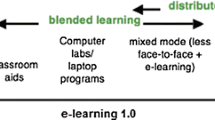Abstract
In this paper we present the Collaborative Computing Frameworks (CCF) as an integration platform for e-learning. The capabilities of the CCF facilitate mixed modes of delivery and the possibility to integrate already existing e-learning platforms. The CCF features allow to form different groups during the learning process. This coupled with peer-to-peer communication facilities, promotes the efficient implementation of collaborative technologies as an important component of the Dialogue phase of the learning process. The new Collaborative Computing Transport Layer (CCTL) will allow wireless devices to be experimented with for the purposes of e-learning. It is envisaged that this direction will dramatically widen the possibilities for content delivery.
Supported by European Commission grant 2001-3450/001-001 EDU ELEARN.
Chapter PDF
Similar content being viewed by others
References
K. P. Birman. Building Secure and Reliable Network Applications. Prentice Hall, 1997. Out of print, but an online version is available at: http://www.cs.cornell.edu/ken/.
S. Chodrow, S. Cheung, P. Hutto, A. Krantz, P. Gray, T. Goddard, I. Rhee, and V. Sunderam. CCF: A Collaborative Computing Frameworks. In IEEE Internet Computing, January / February 2000.
Lynne Coventry. Videoconferencing in higher education. Technical report, Institute for Computer Based Learning, Herriot Watt University, 1997. Available from: http://www.man.ac.uk/MVC/SIMA/video3/contents.html.
Martin Curley. Peer-to-peer Enabled e-Learning and Collaboration. In Proc. 2002 International Conference Computational Science, Lecture Notes in Computer Science. Springer-Verlag, April 2002. In press.
Genius-generic e-learning environments and paradigms for the new pan european information and communication technologies curricula. EC project, 2001-2003.
B. Glade, K. P. Birman, R. Cooper, and R. Renesse. Light Weight Process Groups In The ISIS system. Distributed Systems Engineering, 1:29–36, 1993.
J. S. Pascoe, V. S. Sunderam, and R. J. Loader. Working Towards Strong Wireless Group Communications: The Janus Architecture. In Proc. 2002 International Conference Computational Science, Lecture Notes in Computer Science. Springer-Verlag, April 2002. In press.
I. Rhee, S. Cheung, P. Hutto, A. Krantz, and V. Sunderam. Group Communication Support for Distributed Collaboration Systems. In Proc. Cluster Computing: Networks, Software Tools and Applications, December 1998.
I. Rhee, S. Cheung, P. Hutto, and V. Sunderam. Group Communication Support for Distributed Multimedia And CSCW Systems. In Proc. 17th International Conference On Distributed Systems, May 1997.
Trace A. Urdan and Cornelia C. Weggen. Corporate e-Learning; exploring A New Frontier. Equity Research, March 2000.
R. van Renesse, K. P. Birman, and S. Maffeis. Horus, A Flexible Group Communication System. In Communications of the ACM, April 1996.
Various. Teaching at an internet distance: The pedagogy of online teaching and learning. Technical report, University of Illinois, 1999. Available from: http://www.vpaa.uillinois.edu/tid/report/tid_report.html.
Author information
Authors and Affiliations
Editor information
Editors and Affiliations
Rights and permissions
Copyright information
© 2002 Springer-Verlag Berlin Heidelberg
About this paper
Cite this paper
Alexandrov, N., Pascoe, J.S., Alexandrov, V. (2002). Collaborative Computing and E-learning. In: Sloot, P.M.A., Hoekstra, A.G., Tan, C.J.K., Dongarra, J.J. (eds) Computational Science — ICCS 2002. ICCS 2002. Lecture Notes in Computer Science, vol 2330. Springer, Berlin, Heidelberg. https://doi.org/10.1007/3-540-46080-2_73
Download citation
DOI: https://doi.org/10.1007/3-540-46080-2_73
Published:
Publisher Name: Springer, Berlin, Heidelberg
Print ISBN: 978-3-540-43593-8
Online ISBN: 978-3-540-46080-0
eBook Packages: Springer Book Archive




